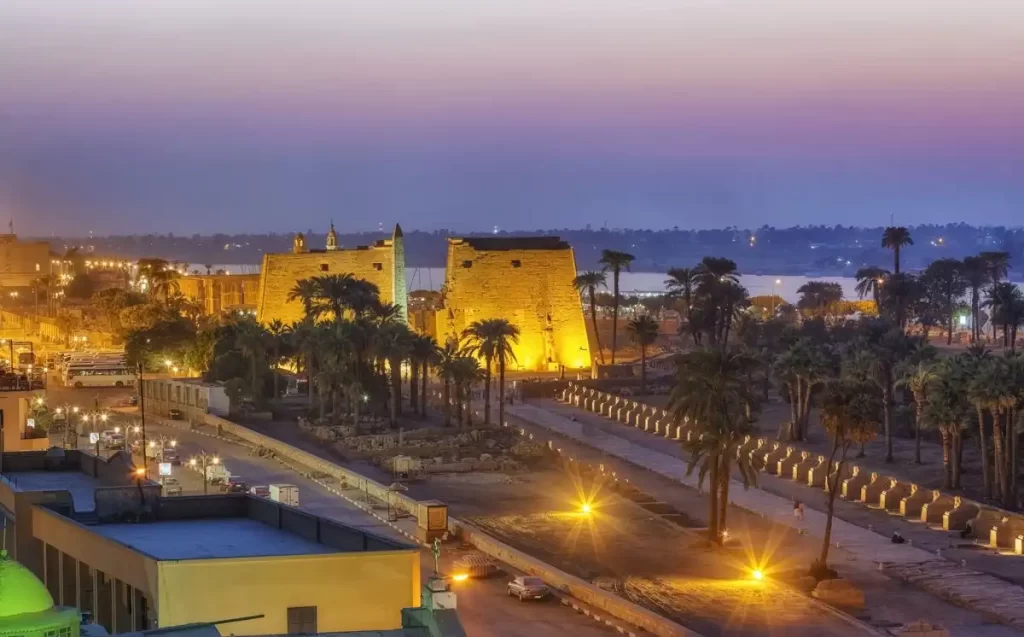
Luxor
[ez-toc]
If one aspires to transcend the confines of time and space in order to experience Ancient Egypt’s splendor in the most stunning way, Luxor possesses the power of the sun, which may give life and arouse a sense of beauty and wonder in the spirit. This article’s major objective is to provide all travelers with accurate information on the fabled city of Luxor. This post was created by a team of knowledgeable and experienced tour guides, tour operators, and travel advisors that are quite knowledgeable about the enchanted city of Luxor. The capital of the Pharaohs of Ancient Egypt from the 16th to the 11th century B.C., Luxor is the location of ancient Thebes, one of the oldest and most populous cities on Earth. This explains how it came to be regarded as the city of the perpetual monarchy.
Many people believe Luxor, the city of a hundred doors, to be the world’s largest outdoor museum because it is home to some of the most magnificent temples, including the Valley of the Kings, the Karnak Temple, Queen Hatshepsut Temple, and the Luxor Temple, which houses some of the most extraordinary monuments and artifacts. A part of the ancient city of Thebes, Luxor is situated on the east bank of the Nile River in the southern region of Upper Egypt. In the Old Kingdom, Luxor was regarded as a very significant city, and in the New Kingdom, Luxor served as Egypt’s capital.
Location of Luxor
Luxor is a city in Upper Egypt that has a population of over 500,000 people and is located on the eastern and southern banks of the Nile River. Its economy is mostly based on tourism.
Luxor Etymology
As the Greeks called it “Thebes” and the ancient Egyptians called it “Waset,” Luxor was a very significant city. The Arabic name for Luxor today, Al-Uqur, translates to “The Palaces” or “The Forts” and comes from the Latin castrum, which means “fortified camp” in Roman. The Arabic name for Luxor today is “The Palaces,” and it was also known as “The City of Hundred Doors” in antiquity.
Climate of Luxor
Luxor experiences an extremely hot and sunny environment, with summertime highs of 40 C (104 F) and wintertime lows of 22 C (71.6 F). Millions of people travel to the city from all over the world to see the amazing wonders that exist there.
The History of Luxor
Thebes, which translates to “the city of one hundred doors” and “the city of Amun,” was the center of worship for the Theban triad, which included the creator sun god Amun-Ra, his wife, the goddess of truth and justice Mut, and her son Khnosu, the moon god. Luxor’s history reveals that the city had a strong religious foundation. Ancient Egyptian queens really credited Amun, the Deity of Gods, with fathering their own offspring, making the city the abode of the god Amun and a physical representation of the bond between Amun and Egyptian royalty. The city of the gods, where the Karnak temple serves as the official place of worship, Luxor was very significant during the 11th dynasty, the early middle kingdom (2050-1652 BC), the 12th dynasty (1938-1756 BC), and later in Egypt’s new kingdom. Each god had a shrine there, including Amun-Re, Mut, and many others.
When the Old Kingdom fell, Luxor served as a provincial administrative hub, but with the advent of the Middle Kingdom during the “first intermediate period,” Luxor was transformed into the capital of the new Egyptian kingdom. The city’s importance increased with the start of the 11th dynasty during the early middle kingdom, leading to the new kingdom, where it was made the capital and a focal point for all areas of Ancient Egypt’s politics, religion, and military. As King Amenhotep III built the temple of the god Amon, his consort the goddess Mut, and their son Khonsu the moon excellent A.K., many kings and queens built several temples to honor the gods from the 18th to the 20th Dynasty. The power of Amon increased as he combined with the sun god Ra to become Amun-RA, who was worshipped at his time within the Karnak Temples Complex, in a Luxor temple in the late 18th dynasty.
After a period of civil strife and upheaval, King Akhenaton (1353–1336 BC) tried to impose Atonism (the worship of the one god Aton) on the country when he moved the capital to the city of Amarna, but he was unsuccessful. It became customary for any king or queen during the new kingdom to be buried in the Valley of the Kings, which contains 63 royal tombs, including those of Ramses the Great, Tutankhamen, Thutmose III, Nefertari, and many others. These kings and queens included Ramsess II (1279–1213 BC) and Hatshepsut (1507–1458 BC), who wanted to immortalize her legacy. The magnificent temple of Hatshepsut in Luxor is well known for embodying the period’s authentic creative design and classical construction. Alexander the Great was among the last historical figures to contribute something new to the city since a granite altar to him was constructed in the Luxor temple.
Even after the Greek, Roman, Coptic, and Islamic eras arrived in Luxor and numerous churches and mosques were erected close to or even on some of the temples, Luxor continued to be a window to ancient Egyptian history. Every day, Luxor continues to astound us with new discoveries. In 1979, UNESCO designated Luxor, the Karnak temple complex, the Valley of the Queens, and the Valley of the Kings as World Heritage Sites. Numerous excavations, repairs, and preservation projects are currently in progress today. The Egyptian Antiquities Organization discovered numerous statues from the 18th dynasty in 1988. Modern Luxor is a market town that provides services to all the nearby agricultural districts. Additionally, most people there are Christians. In addition, the town boasts a ferry service to the western bank, an airport, and the magnificent Luxor Museum, which opened in 1975 to provide visitors from all over the world a glimpse into the amazing history and culture of ancient Thebes.
Best Attractions in Luxor
Tourist destinations are world-renowned jewels comprised of opulence and physical attractiveness. Located all around the city, Luxor was recognized by UNESCO as a World Heritage Site in 1979. The enormous Colossi of Memnon, the city’s heavenly protector, is located at the entrance, and the Heavenly Valley of the King, in the middle of a mountain, contains 20 tombs of New Kingdom kings and queens, including the Ramesses dynasty, Tutankhamun, Seti I, Amenhotep I, Thutmose, and many others, along with 63 tombs for various members of royalty and nobility. The magnificent valley of the nobles, which has 500 tombs of nobility, governors, and tax collectors as well as wall images and wall decorations that depict their daily lives in great detail, is another exceptional landmark.
The stunning Queen Hatshepsut Temple, which was constructed in 1479 BC, is one of the most well-preserved temples in all of Egypt and the finest example of ancient Egyptian architecture. One of the oldest and most magnificent temples in Luxor, the Great Luxor Temple, also known as the southern sanctuary, was constructed about 1400 BCE and was devoted to the Theban Triad.
One of the greatest open-air museums in the world, the vast Karnak temple complex, also known as the most chosen of Places, was created to record the spiritual evolution of the entire ancient Egyptian culture. The Karnak temple complex, which has shrines, kiosks, and obelisks honoring the deity of ancient Thebes and the splendor of pharaohs stretching back more than 3500 years, is a divine treasure that once served as the most significant center of worship in Ancient Egypt. The Temple of Amun-Ra, one of the biggest religious complexes in the world, dominates Luxor. The hall of the Karnak Temple is well known for being lined with enormous papyrus-shaped columns. The Karnak temple complex, which has shrines, kiosks, and obelisks honoring the deity of ancient Thebes and the splendor of pharaohs stretching back more than 3500 years, is a divine treasure that once served as the most significant center of worship in Ancient Egypt. The majority of the structures were constructed by the pharaohs of the 18th to 20th dynasties (1570–1090 BC). The fabled 3 km-long avenue of sphinxes with human heads that connects the magnificent Temple of Amun at Karnak with Luxor Temple is a true wonder to behold.
Things to Do in Luxor
Every visitor to Luxor will have the opportunity to explore all the ancient historical sites located throughout the city, in addition to the many shops and bazaars where they can purchase lovely trinkets, board a magnificent hot air balloon, and go inside the sound and light show to see the history of ancient Egypt come to life. Every traveler has the opportunity to take a Nile boat from Luxor to Aswan, where they may thoroughly discover all the ancient Egyptian sights. There is also the incredible Luxor Museum, which houses the most unique collection of ancient Egyptian artifacts.



